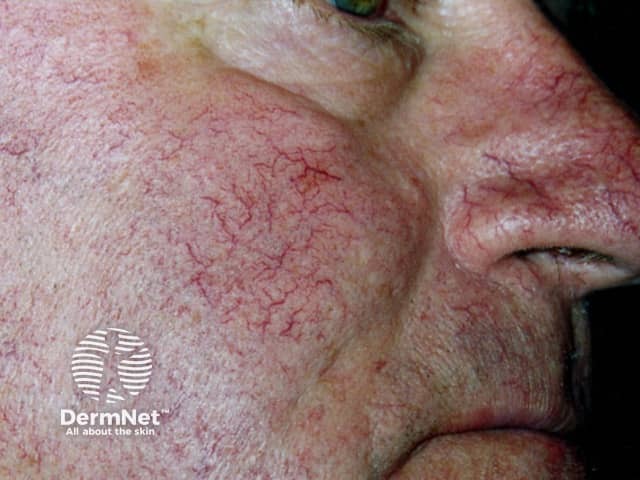Main menu
Common skin conditions

NEWS
Join DermNet PRO
Read more
Quick links
Copper bromide laser — extra information
Copper bromide laser
Author: Dr Amanda Oakley MBChB FRACP DipHealInf, Department of Dermatology, Waikato Hospital, Hamilton, New Zealand, 2001.
The Copper Bromide laser system has its output as yellow and/or green light, usually as brief pulses of 10 to 50 milliseconds of up to 2 watts.
Yellow light is used very effectively to treat vascular lesions (red)
- Facial telangiectasia
- Spider telangiectasis, cherry angiomas and venous lakes
- Small port wine stains (vascular malformations).
The small spot size makes it impractical to treat large port wine stains effectively. Laser treatment is much more effective and better tolerated than diathermy or electrolysis.

Telangiectasia

Telangiectasia
Green light is used to treat pigmented lesions (brown)
- Lentigines
- Freckles
- Benign moles.
It is important that the diagnosis is clear: the copper bromide laser should not be used to treat melanoma.
Combined yellow and green light is sometimes used to treat skin coloured surface skin lesions as an alternative to cryotherapy (freezing) or surgery.
- Seborrhoeic keratoses
- Actinic keratoses
- Skin tags
- Dermatosis papulosa nigra
- Trichoepitheliomas
- Adenoma sebaceum
- Warts
- Benign moles.
To eliminate the danger of the laser light burning the back of the eye (the retina), the patient's eyes are covered with steel or lead eye shields. The laser operator must wear special goggles that permit reasonable vision while protecting his or her vision from injury. Goggles are also available for another person to observe the treatment.
The patient lies in a comfortable chair or couch. Local or general anaesthetic is not usually necessary for copper bromide laser treatment, which is generally well tolerated by adults and older children. It is felt as a brief burning or prickling sensation.
Treated vascular lesions blanch briefly when exposed to the yellow light. A single session rarely exceeds 40 minutes, depending on the extent of the skin problem. The treated skin appears quite red for a few hours. The following day there may be localised swelling and crusting eyelid swelling is occasionally quite severe but rarely lasts more than a few days.
The green light causes the surface of pigmented lesions to go grey and then form a dark scab. After a couple of weeks the skin peels off leaving a paler lesion. Combined light acts like electrocautery and destroys lesions that can be scraped off easily.
For best results, most patients require two to four treatments , usually at intervals of at least six weeks.
